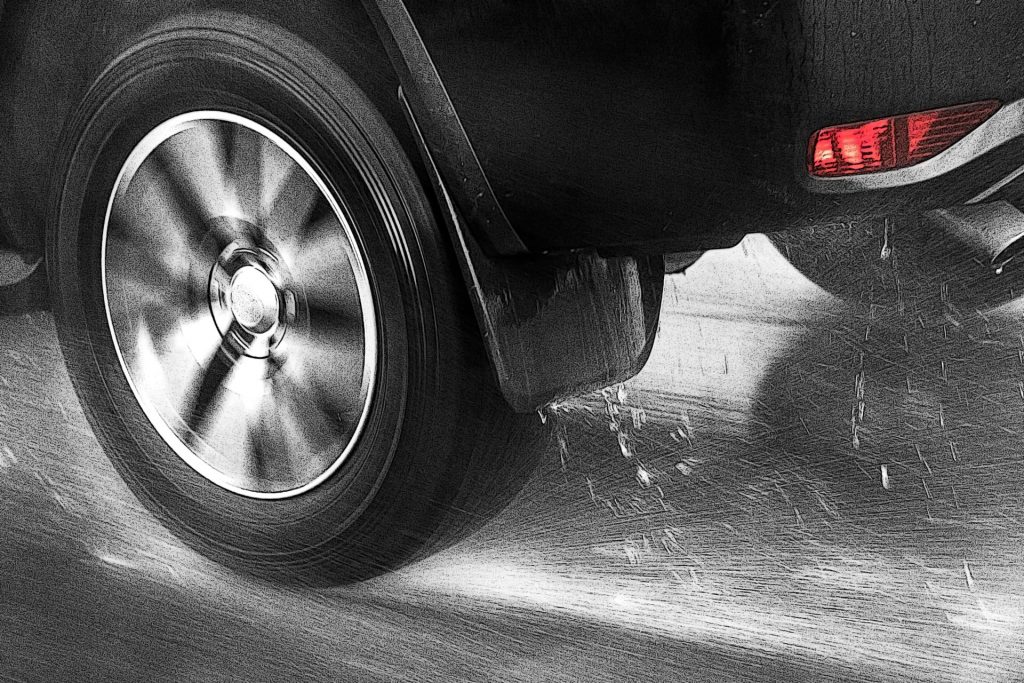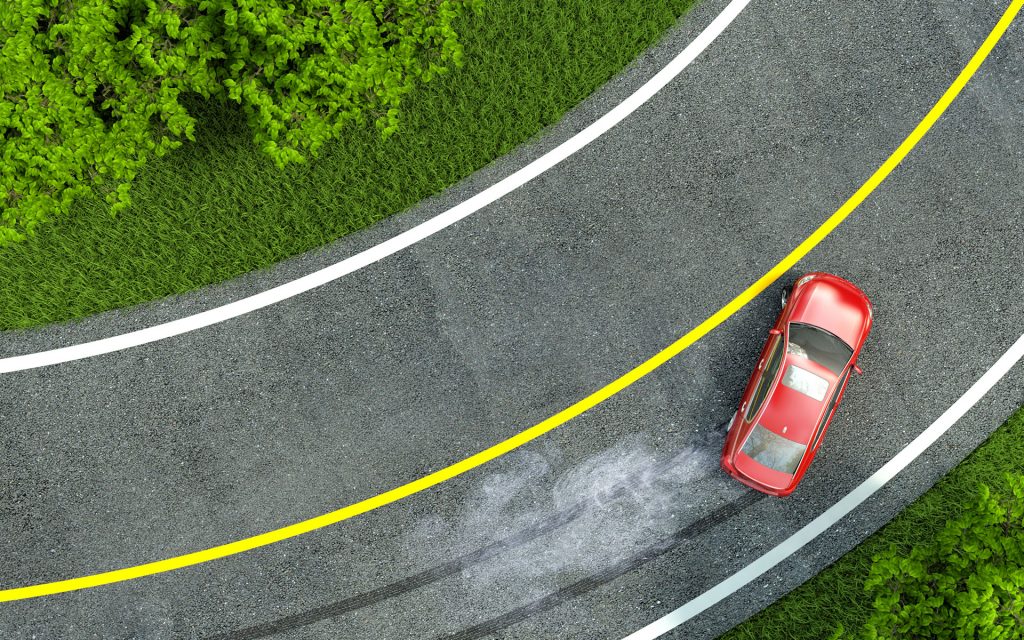How to Recover from Rear Wheel Skids/Slides
Safe driving is a very busy task, involving watching for vehicles, bicycles, and pedestrians while still trying to stay on the road without being in an accident or causing problems for others. One of the most important factors in safe driving is being able to control the vehicle under hazardous road conditions. However, this task can be difficult, and it is easy to start skidding when the conditions are not ideal. When a rear wheel skid or slide occurs, drivers should know how to correct the vehicle’s movement to get back on track as quickly as possible.
Rear wheel skids are common enough in Canada to have their own nickname: fishtailing. The name comes from the resemblance of the vehicle to the flopping tail of a fish as if goes back and forth rapidly. In these types of skids, the back end of the vehicle slides back and forth several times, often when the driver is braking. Sometimes, this movement is minor and requires little response from the driver, but it can sometimes be serious enough to cause accidents unless the driver acts quickly to correct it.
Misleading Advice
As Jason Tchir explains in his January 2020 Globe and Mail article, the advice that people often receive regarding turning into the skid can be misleading. Instructors often tell students to steer into the skid, but it can be difficult to determine exactly which way the vehicle is skidding, especially in a crisis. If the driver hesitates through confusion, even for a few moments, the results could be deadly. Guessing the wrong direction could also be extremely hazardous, as the driver may inadvertently cut off other traffic and potentially cause major problems on the road.
Besides the possibility of confusion, drivers can easily overcompensate for the skid and potentially run their vehicles into the ditch or boulevard or into other road users. This situation is potentially extremely dangerous, especially at highway speeds. Even at lower speeds, overcompensating for a slide or skid can cause drivers to lose control of their vehicles, possibly with disastrous results.
Many of the dangers associated with confusion or overcompensation relate to drivers’ level of experience. After years of driving in areas where skids are common, drivers gain the knowledge and instincts they need to make the correct reactions almost automatic. However, new drivers or people who drive only rarely might not have the experience to be able to respond quickly to a skid and to make the right choices.
Different Types of Skids
Learning often involves both theory and practice. The first step for new drivers and for people who need to review the techniques is to learn the theory behind recovering from a skid. Learning the difference between a front-wheel and rear-wheel skid is important, as the techniques differ slightly. However, looking for similarities in the response can also be helpful, especially for times when the driver is unsure which wheels are skidding.

Taking time to practice in a safe setting is a good idea before drivers get out onto busy streets. It may be difficult to anticipate the exact form that a skid will take, but practicing the response can be helpful. Some vehicles respond to the slightest turn of the wheel or pressure on the brake or accelerator, while others require much more driver input. Practicing in an empty parking lot or other open space can help drivers anticipate the necessary steps they must take in a skid on the road.
Another aspect for drivers to consider is the effect of the terrain on skidding. If a vehicle is especially prone to skidding while going uphill, for example, drivers should try to practice on a slope if there is a safe place to do so. It may require special techniques to keep the driver from losing control. Similarly, a vehicle that frequently skids while going downhill may require a lower speed than other vehicles.
How to Counteract Skids
To help counteract the tendency towards skidding, vehicle owner should check the tires to ensure that they have the correct amount of tread and that they are not excessively worn down. If they are all-season tires, the owners should consider getting a separate set of winter and summer tires to get the best traction for each season.
Vehicles work best and are most stable when all of the wheels have the right amount of contact with the road, as the Autotrader website notes. In rear-wheel drive vehicles, most of the weight rests on the front wheels, while the opposite is the case with front-wheel drive vehicles. In a skid, the weight distribution can change, making the vehicle unstable. All-wheel drive vehicles are normally less prone to skidding or sliding because their power is more evenly distributed, and all of the wheels have equal contact with the road.
Rear Wheel Skids
Rear wheel skids are most likely to happen in vehicles with rear-wheel drive because much of the weight is over the front wheels, giving them larger contact patches and thus better grip than at the back. Thus, vehicles with front-wheel drive tend not to experience rear-wheel skids very often, although they can occur occasionally.

Often, the type of vehicle determines whether it is front-wheel, rear-wheel, or all-wheel drive. As the Pickup Trucks News site explains, rear-wheel drive is standard in most trucks, while front-wheel drive is more common in vehicles such as cars. Despite the extra weight on the rear wheels of trucks, the length of a relatively empty rear end of the vehicle can mean that the rear wheels of trucks are prone to slipping.
Whatever the type of vehicle, skidding and slipping on the road tends to happen at times when the vehicle’s speed or direction changes. Going around a corner too quickly or stopping and starting can cause the vehicle’s wheels to lose their grip and to begin to skid. Often, the problem occurs when the vehicle is moving too quickly or the conditions, especially on somewhat unstable or slippery surfaces like gravel or wet leaves.
Before the Skid
As the Automotive Fleet website explains, drivers’ actions before a skid occurs can be just as important as what they do once the vehicle begins to slide. Fatigue can make drivers’ reactions slow, while panic or distractions can make it difficult for them to make good decisions. Drivers should always assess the possibility of skidding before they take actions that might cause them to lose control of their vehicles. Slowing down sufficiently for a turn, slowly coming to a stop wherever possible and taking sufficient time to start up from a stopping position will help drivers to avoid skidding in many cases.
When a skid does occur, drivers should know how to handle the situation. According to the Autotrader website, one way of recovering from a skid in an all-wheel drive vehicle, for example, is to release the accelerator slowly and to unwind the steering wheel until it is in the right position, doing this slowly enough to avoid any abrupt movements.
Causes of Skids
According to the Canadian Automobile Association South Central Ontario, the method for getting out of a skid depends on the initial cause of the skid. For skids that result from braking too hard, the best technique is to release the brake to allow the tires to begin rolling again. Normally, the tires will then begin to regain traction.
When a skid results from accelerating too quickly, the best tactic is to release the gas pedal gradually without braking. Allowing the vehicle to slow down will reduce the spinning motion of the wheels and regain traction. At that point, the driver can begin accelerating again if it is safe to do so.
These tactics work best for automatic transmission vehicles. For manual transmission vehicles, the best technique is to disengage the clutch but not to brake.
Once the vehicle has become stable after a rear-wheel skid, drivers can follow the basic techniques that apply to any type of slide. The first and often simplest technique is to look in the direction that the vehicle should follow. Although this technique seems too easy to be useful, it can help drivers avoid going into a ditch or a barrier, as the hands on the steering wheel tend to follow what the eyes are doing.
Regaining Control
Regaining control of the steering wheel is an essential part of recovering from a skid. As always, adjustments to the steering wheel should be small and controlled rather than the large movements that could make the driver lose control of the vehicle. For rear-wheel skids, looking and steering in to correct direction is the first step. Once the tires are gripping the pavement again and the vehicle is straight, the driver should counter-steer slightly. This tactic can help avoid fishtailing and ensure that the vehicle continues moving forward smoothly.
Knowing how to recover from a skid is important for everyone. Rear-wheel skids can be minor, but they can also potentially be dangerous. With the right techniques and time to practice, drivers can learn to control rear-wheel skids and ensure that they avoid causing problems for themselves and others when they encounter ice, gravel or anything else that might cause them to lose control of their vehicles. Learning the techniques for controlling rear-wheel skids is important for all drivers.
